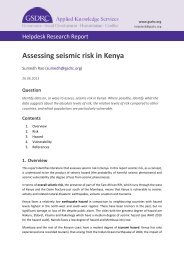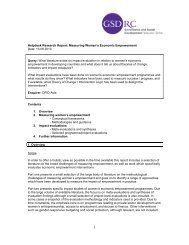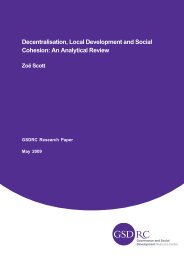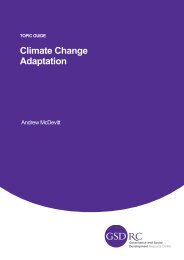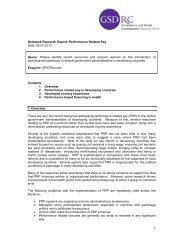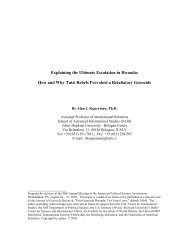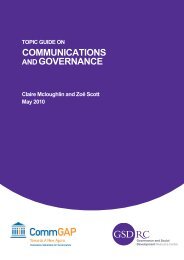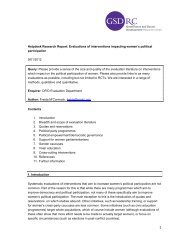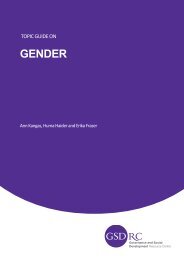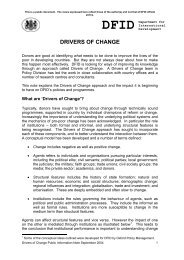Critique of Governance Assessment Applications - GSDRC
Critique of Governance Assessment Applications - GSDRC
Critique of Governance Assessment Applications - GSDRC
You also want an ePaper? Increase the reach of your titles
YUMPU automatically turns print PDFs into web optimized ePapers that Google loves.
Though governance is likely to have an impact on how well and effectively aid is being used(Court et al., 2007), there is still debate over what key issues are for governance reforms andwhether and when aid should be delivered. <strong>Governance</strong> indices can also help in choosingpartner countries but other criteria may be equally if not more important. This includes need orlevels <strong>of</strong> poverty, existing flows, existing donors and international peace and stability.A 2008 survey (OECD, 2008; OECD, 2009) illustrated donors‘ approaches to governance. Inparticular they note that donors fail to build on country systems or harmonise with them, andthey <strong>of</strong>ten lack clear purpose to drive the choice <strong>of</strong> assessment tools. <strong>Governance</strong>assessments are generally driven by agency needs and concerns. There seems to be lessinterest in learning about the links between governance factors and development outcomes.To enhance the use <strong>of</strong> the results <strong>of</strong> governance assessments the recommendations are thatassessments should be linked to programming, that there should be field-driven demand forthe assessment and that donor staff should be involved in the process. Furthermore thereshould be removal <strong>of</strong> institutional disincentives such as disbursement pressures and thereshould be a link to conditionalities to provide incentive to countries to improve theirgovernance. UNDP (2009) also recommends that it is important to practice democraticgovernance during the process <strong>of</strong> governance assessment itself.Unsworth (2005) comments that the impact <strong>of</strong> donor assistance to improving governance hasbeen modest. Donors lack understanding <strong>of</strong> political and institutional context, and their effectson this. Others argue for a better understanding <strong>of</strong> the indicators used and provide guides forusing and choosing indicators in assessments (Kaufmann and Kraay, 2002; UNDESA, 2007;Sudders and Nahem, 2004).Initiatives for Improving <strong>Assessment</strong>sKnack et al (2003) has argued for a ‗second-generation‘ <strong>of</strong> indicators which are generatedthrough a transparent process, available across many countries over time, <strong>of</strong> high quality,accurate and specific. In particular they note that ‗first-generation‘ indicators have <strong>of</strong>tenlacked sensitivity to the <strong>of</strong>ten-justified concerns <strong>of</strong> government.Hood et al (2008) suggests creating a ranking <strong>of</strong> different types <strong>of</strong> governance assessmentmethodologies. This is to move beyond both uncritical acceptance and overt scepticism <strong>of</strong>governance assessments.Crawford (2003) criticises the logical framework approach and advocates a ‗genuinely‘participatory approach to governance assessments. Here informed national actors are to takecontrol <strong>of</strong> the evaluation process and provide the key input <strong>of</strong> local knowledge and analysis.In particular Crawford stressed that the process <strong>of</strong> governance assessment can and shouldbe used as a tool for building democratic governance itself.UNDP (2007) emphasize that media and civil society should play a greater role in governanceassessments. They also note that there will always be a plurality <strong>of</strong> methods and purposes ingovernance assessments.2. General critiquesArndt C., 2008, 'The Politics <strong>of</strong> <strong>Governance</strong> Ratings', International Public ManagementJournal, vol. 11, no. 3, pp 275 - 297.http://www.informaworld.com/smpp/content~db=all~content=a901675358This article helps situate governance assessments in a political context. The most populargovernance indicators are perception-based composite indicators, primarily <strong>of</strong> use tointernational organisations, donors, investors and the media. These indicators summarisevast amounts <strong>of</strong> data that exists for a large number <strong>of</strong> countries, but there are significantdrawbacks. A small number <strong>of</strong> indicators are currently dominant because users do not grasptheir limitations, and possible alternatives are not well known. There are a small number <strong>of</strong>3
indicators which are widely used – the World Bank‘s World <strong>Governance</strong> Indicators (WGIs),Transparency International‘s Corruption Perceptions Index (CPI), and the WorldBank/International Finance Corporation Doing Business Indicators. These indicators facelimitations with respect to comparability over time, transparency and feasibility <strong>of</strong>implementation.There is a growing resistance on the part <strong>of</strong> developing countries to indicators that areperceived as ‗Western‘ and are primarily used by outsiders. However, new indicators haveemerged, which tend to focus on specific and well-defined aspects <strong>of</strong> governance andtherefore give guidance to developing countries on how to improve their rating. At the sametime, until a theory <strong>of</strong> governance is able to guide the construction <strong>of</strong> meaningful indicators <strong>of</strong>the overall quality <strong>of</strong> governance, the development community should focus on such specificand well-defined indicators.Kaufmann D., and Kraay A., 2007, 'On Measuring <strong>Governance</strong>: Framing Issues forDebate', Issues paper prepared for the January 11 2007 Roundtable on Measuring<strong>Governance</strong>, World Bank, Washington, D.C.http://siteresources.worldbank.org/INTWBIGOVANTCOR/Resources/1740479-1149112210081/2604389-1167941884942/On_Measuring_<strong>Governance</strong>.pdfThis World Bank paper highlights key issues for users and providers <strong>of</strong> governanceindicators. It contends that: (1) all governance indicators have weaknesses; (2) there are noeasy solutions in measuring governance; and that (3) the links from governance todevelopment outcomes are complex. Any proxy for governance is by definition an imperfectmeasure <strong>of</strong> broader governance dimensions. The failure to disclose margins <strong>of</strong> error may leadto a false sense <strong>of</strong> accuracy or to an over-interpretation <strong>of</strong> small changes over time or acrosscountries. Even 'improved' indicators (such as 'second-generation' and 'actionable' indicators)are insufficient in themselves. Policymakers should view the different types <strong>of</strong> indicators ascomplementary rather than competing. Outcome indicators are also important for measuringwhat is happening on the ground, taking account <strong>of</strong> the views <strong>of</strong> citizens, the private sectorand experts. The complex relationship between governance and development outcomes mustbe taken into account when measuring governance.Molutsi, P., 2002, ‘Tracking Progress In Democracy And <strong>Governance</strong> Around TheWorld: Lessons And Methods’ United Nations Online Network in Public Administrationand Financehttp://unpan1.un.org/intradoc/groups/public/documents/un/unpan005784.pdfThe paper says that development and use <strong>of</strong> indicators has not been well received by thegovernments and others in developing countries. Some see them as tools for exclusionwhereby donors and financiers might use the low rating <strong>of</strong> a country to justify denial <strong>of</strong> aid orset conditionality for any assistance to the country. Others have seen the use <strong>of</strong> indicatorsand ranking <strong>of</strong> countries as efforts to embarrass and undermine their efforts to promotedemocracy and good governance. The use <strong>of</strong> indicators and assessments vary from oneparticular interest group and organization to another. However, the paper says, the relevance<strong>of</strong> assessments as promotional tools for assisting democratization should not be overlooked.What is most required in new and restored democracies today is more dialogue betweenleaders and their people and with other stakeholders. Only dialogue will translate theconstitutional provisions and institutional frameworks <strong>of</strong> democracy into culture and practice.3. <strong>Critique</strong>s <strong>of</strong> measurementBesancon, M., 2003, ‘Good <strong>Governance</strong> Rankings: The Art <strong>of</strong> measurement’, WorldPeace Foundation Report, No. 36, Cambridge, MAhttp://belfercenter.ksg.harvard.edu/publication/2077/good_governance_rankings.html4
This paper synthesises ideas and opinions from ―The Conference on Measuring <strong>Governance</strong>‖at the Kennedy School, Harvard University, in May 2003. Objectively measuring governancecould lead prescriptively to improving the welfare <strong>of</strong> those in the developing world.Measurements matter where international organisations allocate large sums <strong>of</strong> money todeveloping nations and base disbursements on good governance. Good measurements canincrease the rigour <strong>of</strong> discussions by policymakers and research communities in the G8 andby civil society. A comparative aggregate rating index may act as a ―shaming‖ mechanism oras an incentive for developing nations to reduce corruption and improve their economies.Alternatively, aggregate governance indicators could constitute political leverage that could beused by elites to mobilise constituents. The consensus among the conference participantswas that better, more explicit measures <strong>of</strong> governance were possible. Until a single approachis agreed upon, greater coordination amongst data compilers and theorists is needed.Williams, A. and Siddique, A., 2008, ‘The use (and abuse) <strong>of</strong> governance indicators ineconomics: a review’ Economics <strong>of</strong> <strong>Governance</strong> 9:131–175http://www.springerlink.com/content/3630401q64n33424/fulltext.pdfThis study provides an overview and introduction to the common governance indicators usedin empirical analysis with a detailed appendix <strong>of</strong> the papers used. This study reviews:‣ Objective measures: measures <strong>of</strong> political instability and violence, political institutions,polity database, database <strong>of</strong> political institutions, political constraint index.‣ Subjective measures: Freedom house index <strong>of</strong> civil and political liberties, Internationalcountry risk guide (ICRG), Business Environment Risk Intelligence, BusinessInternational, Country Policy and Institutional <strong>Assessment</strong> (World Bank CPIA).‣ Survey based data‣ Composite rankings: Transparency International, <strong>Governance</strong> indicators (‗KKZindicators‘), Economic freedom index (EFI)‣ ‗Second generation‘ indicatorsThe paper reviews the methodology <strong>of</strong> the indicators and point out issues researchers shouldtake note <strong>of</strong> when trying to quantify governance. The authors note that there is no perfectmeasurement; different measures have their strengths and limitations and researchers needto be aware <strong>of</strong> this. They must make sure that they are specific in which aspect <strong>of</strong> governancethey are purporting to investigate and whether the data they are using is as accurate arepresentation as possible.Arndt, C. And Oman, C., 2006, ‘Uses and Abuses <strong>of</strong> <strong>Governance</strong> Indicators’ OECDDevelopment Centre, OECDhttp://www.oecd.org/dataoecd/21/16/40037762.pdfThis study critiques the validity <strong>of</strong> governance indicators and their uses. The most widely usedgovernance-indicator datasets are composite perceptions-based indicators. These indicatorslack transparency and comparability over time, suffer from selection bias, and are not wellsuited to help developing countries identify how effectively to improve the quality <strong>of</strong> localgovernance. This is not widely perceived by users. User groups are mainly internationalinvestors, <strong>of</strong>ficial national and multilateral aid agencies, and development analysts andacademics -- mostly people located outside developing countries. They tend to use — andwidely misuse — governance indicators to compare the quality <strong>of</strong> governance both amongcountries and over time in their decision-making processes. The authors note that the perfectgovernance indicator will never exist. The production and use <strong>of</strong> more transparentgovernance indicators will better serve the needs <strong>of</strong> both external users and developingcountries seeking to improve the quality <strong>of</strong> local governance. The authors also argue for astronger ―market‖ for governance indicators; use <strong>of</strong> a wider range <strong>of</strong> indicators; and to movebeyond the distinction between relatively transparent indicators built to serve the policy needs<strong>of</strong> developing countries, on the one hand, and composite perceptions-based indicators forcross-country comparisons, on the other.5
Kaufmann, D., and Kraay, A., 2007, ‘<strong>Governance</strong> Indicators: Where are We, WhereShould We Be Going?’ World Bank Policy Research Working Paper No. 4370http://go.worldbank.org/7N5G6TDUI0This paper reviews progress to date in measuring governance, using a framework <strong>of</strong> analysisfocusing on two key questions: (i) what is measured? and (ii) whose views are relied on? Forquestion (i), the authors distinguish between indicators measuring formal laws or rules 'on thebooks', and indicators that measure the practical application or outcomes <strong>of</strong> these rules 'onthe ground', calling attention to the strengths and weaknesses <strong>of</strong> both types <strong>of</strong> indicators aswell as the complementarities between them. For question (ii), the authors distinguishbetween experts and survey respondents on whose views governance assessments arebased, again highlighting their advantages, disadvantages, and complementarities. Theauthors also review the merits <strong>of</strong> aggregate as opposed to individual governance indicators.The authors point to several recommendations: transparently disclose and account for themargins <strong>of</strong> error in all indicators; draw from a diversity <strong>of</strong> indicators and exploitcomplementarities among them; submit all indicators to rigorous public and academicscrutiny; and, in light <strong>of</strong> the lessons <strong>of</strong> over a decade <strong>of</strong> existing indicators, be realistic in theexpectations <strong>of</strong> future indicators.Knack, S., 2006, ‘Measuring Corruption in Eastern Europe and Central Asia: A <strong>Critique</strong><strong>of</strong> the Cross-Country Indicators’, World Bank Policy Research Working Paper WPS3968http://go.worldbank.org/3OCGP6XX60This paper assesses corruption levels and trends among countries in the transition countries<strong>of</strong> Eastern Europe and Central Asia (ECA) based on data from several sources that are bothwidely used and cover most or all countries in the region. The paper concludes thatdepending on one's purpose, it may be more appropriate to use data from a single sourcerather than a composite index because <strong>of</strong> the loss <strong>of</strong> conceptual precision in aggregation.A second conclusion is that the gains in statistical precision from aggregating sources <strong>of</strong>corruption data likely are far more modest than <strong>of</strong>ten claimed because <strong>of</strong> interdependenceamong data sources. The paper emphasizes the need for scaling up data initiatives to fillsignificant gaps between our conceptual definitions <strong>of</strong> corruption and the operational definitionembodied in the existing measures.Hoyland, B., Moene, K., Willumsen, F., 2009, ‘The tyranny <strong>of</strong> international indexrankings’ Research Programme on Democracy, Democracy as Idea and Practicehttp://www.demokrati.uio.no/arrangementer/konferanser/2010/Hoyland-Moene-Willumsen-TyrannyIndexRankings-2009.pdfThis paper reviews international index rankings and determines that they are ‗too persuasive‘.The UN Human Development Index, Freedom House‘s Freedom in the World, and the WorldBank‘s Doing Business index all provide country rankings that ignore inherent uncertainty.Re-estimated with a method that captures this uncertainty, the authors argue that the practice<strong>of</strong> ranking every adjacent country ends up emphasizing imaginary differences betweencountries as if they were distinct and real. The indexes may be poor guides for policies aseach link between indicators and scores is noisy and uncertain, but presented as certain.4. Worldwide <strong>Governance</strong> Indicators (WGI)Kaufmann, D., Kraay, A. and Mastruzzi, M., 2007, 'The Worldwide <strong>Governance</strong>Indicators Project: Answering the Critics', The World Bank, Washington, D.C.http://siteresources.worldbank.org/INTWBIGOVANTCOR/Resources/1740479-1149112210081/2604389-1167941884942/Answering_Critics.pdfThis paper summarises and responds to recent critiques <strong>of</strong> the WGI. Such criticisms relate tothe following five areas. (1) The WGI are ill-suited to comparisons over time and between6
countries. Such comparisons could be distorted by the diversity <strong>of</strong> data sources and the factthat changes may merely reflect corrections <strong>of</strong> past errors. Comparisons may also beimpeded by the lack <strong>of</strong> precision in the WGI and the fact that indicators are scaled to producethe same global average in each period. (2) The WGI are analytically biased. Sincecommercial organisations provide some <strong>of</strong> the data, the results are slanted towards thepriorities <strong>of</strong> business elites. They also contain ‗halo effects‘ - they are overly influenced bycountries‘ recent economic performance and overall level <strong>of</strong> development. (3) Correlatederrors in the various data sources distort the WGI. Since some sources are interdependent,the benefits <strong>of</strong> aggregation are diminished. Replicated errors in results may also be givenexcessive weight in the WGI. (4) The WGI lack ‗construct validity‘ – many <strong>of</strong> the definitionsemployed are inadequate. Categories used to group governance data lack clear definition andare insufficiently distinguishable from each other. (5) The WGI are insufficiently transparent.Some <strong>of</strong> the data informing the indicators are unavailable to other researchers, thus impedingevaluation, replication and peer review.The authors argue that these criticisms can be rebutted on empirical or conceptual grounds.The re-scaling <strong>of</strong> WGI averages to produce a ‗zero mean‘ for each period and does notimpede comparison as there is little evidence for general changes in world governance levelsover time. The aggregation methodology successfully merges different data sources intocomparable units. Error corrections are not systematic and imprecise results simply reflect theinevitable limitations in governance data. Several non-commercial data sources complementthe business data. In fact, the perceptions <strong>of</strong> businesspeople differ little from other groups.The evidence for ‗halo effects‘ is weak and may merely reflect the causal relation betweeneconomic success and good governance. It is unlikely that interdependent data sources willproduce exactly correlated errors. Even if sources are based on similar data or reports, theiraggregated correlation may merely be evidence <strong>of</strong> accurate results. Some definitionalambiguity is inevitable given the nature <strong>of</strong> governance assessment and should not hinderdata analysis. In fact, the categories selected demonstrate good empirical coherence anddistinguishability. Most <strong>of</strong> the data employed in the WGI is in the public domain andreproduced in the reports themselves. Although the availability <strong>of</strong> the Country Policy andInstitutional <strong>Assessment</strong> ratings to the public is limited, broader criticisms <strong>of</strong> the WGI‘stransparency are exaggerated.‘In-depth Analysis <strong>of</strong> KKZ Composite Indicators’ Chapter 4 <strong>of</strong> Arndt, C. And Oman, C.,2006, ‘Uses and Abuses <strong>of</strong> <strong>Governance</strong> Indicators’ OECD Development Centre, OECDhttp://www.oecd.org/dataoecd/21/16/40037762.pdfThis chapter takes an in-depth look at the strengths and weaknesses <strong>of</strong> what the authorsargue is the most carefully constructed and widely used indicators. This is the KKZ CompositeIndicators, also known as the WGI indicators. Problems associated with their construction oruse, <strong>of</strong> which users seem widely unaware, include: i) the likelihood <strong>of</strong> correlation <strong>of</strong> errorsamong the 37 sources from which the composite WBI indicators are constructed, whichsignificantly limits the statistical legitimacy <strong>of</strong> using them to compare countries‘ scores; ii) theirlack <strong>of</strong> comparability over time; iii) sample bias; and iv) insufficient transparency.Kaufmann, D., Kraay, A. and Mastruzzi, M., 2009 '<strong>Governance</strong> Matters VIII: <strong>Governance</strong>Indicators for 1996-2008', World Bank Policy Research Working Paper No. 4978, WorldBank, Washington, D.C.http://papers.ssrn.com/sol3/papers.cfm?abstract_id=1424591This paper reports on the 2009 update <strong>of</strong> the Worldwide <strong>Governance</strong> Indicators (WGI)research project. The authors explicitly report the margins <strong>of</strong> error accompanying eachcountry estimate. These reflect the inherent difficulties in measuring governance using anykind <strong>of</strong> data. The authors conclude that even after taking margins <strong>of</strong> error into account, theWGI permit meaningful cross-country comparisons as well as monitoring progress over time.7
Thomas, M., 2010, ‘What do the Worldwide <strong>Governance</strong> Indicators Measure?’ EuropeanJournal <strong>of</strong> Development Research 22, 31-54http://www.palgrave-journals.com/ejdr/journal/v22/n1/abs/ejdr200932a.htmlThis paper critiques the ‗construct validity‘ <strong>of</strong> the WGI– whether they measure what theypurport to measure. It raises the question <strong>of</strong> whether researchers and policymakers arerelying on wrong data, rather than poor data.Kaufmann, D., Kraay, A. and Mastruzzi, M., 2010, ‘Response to ‘What do the Worldwide<strong>Governance</strong> Indicators Measure?’ European Journal <strong>of</strong> Development Research 22, 55-58http://info.worldbank.org/governance/wgi/pdf/KKMResponseEJDR2Final.pdfThomas (2009) dismisses the WGI as an ―elaborate and unsupported hypothesis‖ because <strong>of</strong>the failure to demonstrate the ―construct validity‖ <strong>of</strong> these indicators. This paper‘s authorsargue that ―construct validity‖ is not a useful tool to assess the merits <strong>of</strong> the WGI, and even ifit were, Thomas provides no evidence <strong>of</strong> any practical consequences <strong>of</strong> failure to meet thecriteria <strong>of</strong> construct validity.Langbeina, l., Knack, S., 2010 ‘The Worldwide <strong>Governance</strong> Indicators: Six, One, orNone?’http://www.informaworld.com/smpp/content~db=all?content=10.1080/00220380902952399This study uses factor, confirmatory factor and path analysis to test both measurement andcausal models <strong>of</strong> the six Worldwide <strong>Governance</strong> Indicators. They purportedly measure distinctconcepts <strong>of</strong> control <strong>of</strong> corruption, rule <strong>of</strong> law, government effectiveness, rule quality, politicalstability, and voice and accountability. Rather than distinguishing among aspects <strong>of</strong> thequality <strong>of</strong> governance, the authors find that they appear to be measuring the same broadconcept.5. African Peer Review Mechanism (APRM)Chikwanha, A. B., 2007, 'The APRM: A Case Study in Democratic Institution Building?',ISS Paper, no. 151, Institute for Security Studies, Pretoriahttp://www.afrimap.org/english/images/documents/ISSPAPER151.pdfThis paper analyses the progress made by the APRM across the countries which have signedup. The APRM is already showing symptoms <strong>of</strong> becoming ensnared in bureaucracy. Thougha worthwhile exercise in political accountability and institution building, scarce resources havebeen wasted by some <strong>of</strong> the countries involved through hesitancy by both political andtechnical staff. The APRM is proving to be a positive experience in democratic institutionbuilding that will, according to the author, yield benefits in stimulating change in thegovernance and political culture on the continent. However, the process has its limitations.Contestation, disputes and delays are caused by the fact that all authority for the reviewsrests with government. Capacity to gather relevant and reliable information is a majorshortcoming for many African countries and the demands <strong>of</strong> peer review can beoverwhelming in such circumstances. There are variations and different standards in thequality <strong>of</strong> supervision by the Panel <strong>of</strong> Eminent Persons which leads the country reviews.Logistical constraints and occasionally lack <strong>of</strong> political will can delay the APRM process. Theplethora <strong>of</strong> institutions involved at the national level complicate the process. Mistrust <strong>of</strong>government intentions and the fear <strong>of</strong> incorporation by government worsen the tensionbetween government and civil society. Where political tensions are high and trust is low in keypolitical institutions, it cannot be expected that the public will buy into the review processeasily. This lack <strong>of</strong> buy-in can lead to contestation <strong>of</strong> both the process and the findings.8
Herbert, R. and Gruzd, S., 2008, ‘The African Peer Review Mechanism: Lessons fromthe Pioneers’, South African Institute <strong>of</strong> International Affairshttp://www.saiia.org.za/books/the-african-peer-review-mechanism-lessons-from-thepioneers.htmlThis study provides an in-depth analysis <strong>of</strong> the APRM with evaluation <strong>of</strong> the political andsocial dynamics. It provides lessons and recommendations for the APRM as a politicalprocess, how to promote civil society influence and recommendations for the future. Inincludes case studies <strong>of</strong> Ghana, Kenya, Rwanda, Mauritius and South Africa. The appendicesinclude further sources for research on governance, a checklist <strong>of</strong> demands for civil societyand ‗80 Lessons for Success‘ with the APRM.Bing-Pappoe, A., 2007, 'Ghana and the APRM: A Critical <strong>Assessment</strong>', Africa<strong>Governance</strong> Monitoring and Advocacy Project, Open Society Institute for West Africa,Senegalhttp://www.afrimap.org/english/images/report/AfriMAP_APRM_Ghana_EN.pdfThis report evaluates Ghana‘s country self-assessment process. The Ghana APRM selfassessmentis considered to have been robust, flexible, absent <strong>of</strong> political manipulation andlargely participative, and resulted in a detailed programme <strong>of</strong> action. Nevertheless, theprocess had a number <strong>of</strong> weaknesses. When non-governmental research organisations wereappointed as technical research institutes (TRIs) the selection process was closed and theircontracts prevented them from sharing the results <strong>of</strong> their research. Public sensitisationefforts ran concurrently with research for the self-assessment report. This was problematic incases where interviewees for the research process had not yet heard <strong>of</strong> the APRM. Many civilsociety groups felt that there was not enough meaningful consultation. Participants atconsultative meetings were not supplied with documentation prior to meetings, whilst therewas no feedback mechanism on how their inputs were used. The Ghana country selfassessmentreport, submitted to the government and the APRM Panel, has not beenpublished. The same applies to the minutes and reports <strong>of</strong> relevant meetings. The ambiguitiesin APRM documentation regarding the definition and degree <strong>of</strong> involvement <strong>of</strong> civil societyleave important issues up to each country to decide.Jordaan, E., 2006 ‘Inadequately Self-Critical: Rwanda’s Self-<strong>Assessment</strong> For TheAfrican Peer Review Mechanism’ African Affairs, 105/420, 333–351http://afraf.oxfordjournals.org/cgi/content/short/105/420/333This article examines Rwanda‘s evaluation <strong>of</strong> its political governance for the APRM asreflected in the January 2005 version <strong>of</strong> this country‘s self-assessment report. The authorfinds that the report inadequately addresses a number <strong>of</strong> serious political problems inRwanda, such as Rwanda‘s involvement in the Democratic Republic <strong>of</strong> Congo, theinadequate separation <strong>of</strong> powers in the Rwandan political system, tensions in Rwandansociety, and the flawed presidential and parliamentary elections <strong>of</strong> 2003.6. Other assessmentsActionable <strong>Governance</strong> Indicators (AGI)World Bank, 2010, ‘AGI Presentation: An Update (In Full)’http://siteresources.worldbank.org/EXTPUBLICSECTORANDGOVERNANCE/Resources/286304-1235411288968/fULLvERSION.pdf?resourceurlname=fULLvERSION.pdfWorld Bank, 2010, ‘AGI Definition and Measurement Paper’http://siteresources.worldbank.org/EXTPUBLICSECTORANDGOVERNANCE/Resources/286304-1235411288968/AGINote.pdf?resourceurlname=AGINote.pdfAGIs are designed to provide evidence on the characteristics and functioning <strong>of</strong> particularelements and sub-elements <strong>of</strong> the various dimensions <strong>of</strong> governance. They aim to track the9
―missing middle‖ between inputs and outputs, and outcomes. Inputs and outputs here refer tothe project inputs and outputs as well as the programme and policy outputs. Outcomes referto the broader governance outcomes, <strong>of</strong>ten measured at a national level. AGIs are notnecessarily objective and can include subjective or perceptions-based indicators. They aim tobe narrow and explicit to the context to be more actionable which also means they arecontestable in nature. The indicators fall under the themes <strong>of</strong> political accountability, checksand balances, public sector management, civil society and media, private sector anddecentralisation and local participation. The World Bank has produced an AGI Data Portalwhere at present there are 1182 indicators derived from 13 sources.Trapnell, S., 2009, ‘<strong>Governance</strong> Indicators Explanations and Guidance For Usage’World Bankhttps://www.agidata.org/main/video/GuidanceNote_GovIndicators_30Oct09.pdfThis short guidance note is provided with the AGI indicators. It states that before applyingindicators in monitoring or evaluation contexts, it is important to determine the relevance <strong>of</strong>the indicator to a given aim, as well as understand its strengths and weaknesses. The noteoutlines a series <strong>of</strong> questions to be asked <strong>of</strong> any indicator being considered, so as to avoidinappropriate application and to ensure that fair interpretations are made from the data. Theseare: i) What is the aggregated indicator measuring; ii) Are the indicators based on facts orperception; iii) Are the indicators focused on design, capacities, or performance; iv) Arecomparisons over time appropriate; and v) Are cross-country comparisons appropriate.Transparency IndexIslam, R., 2006, ‘Does More Transparency Go Along With Better <strong>Governance</strong>?’,Economics and Politics, vol. 18, no. 2, pp 121-167http://ideas.repec.org/a/bla/ecopol/v18y2006i2p121-167.htmlThis paper presents a new indicator, the ‗Transparency Index‘, to measure the frequency withwhich governments update economic data made available to the public. It also uses theexistence <strong>of</strong> a Freedom <strong>of</strong> Information Act as an indicator <strong>of</strong> transparency. Cross-countryanalysis shows that countries with better information flows, as measured by these indices,have better quality governance. Two transparency indicators are used to analyse therelationship between information flows and governance: a transparency index and theexistence <strong>of</strong> a Freedom <strong>of</strong> Information Act. Regression results show that more transparentgovernments govern better. However, this study uses the WGI indicators as the dependencevariable for the regressions. Thus it is not clear the level <strong>of</strong> conflation between the constructs<strong>of</strong> transparency and governance.Ibrahim IndexBlaser, J, 2008, ‘Notes on the Ibrahim Index’ UNDP Zambia, Staff Opinionhttp://204.200.211.80/joomla/attachments/003_staff_opinion_undp_zambia_2.pdfThe Mo Ibrahim Foundation published a new index in September 2007 ranking theperformance <strong>of</strong> the 48 countries in sub-Saharan Africa. The Ibrahim Index grades countrieson factors such as security, levels <strong>of</strong> corruption, and respect for human rights. This papernotes that the index encounters the same problems associated with other indexes such asweighting, scales, variance truncation, absolute versus relative scores, time and methoddisparities <strong>of</strong> raw data. The Index relies heavily on the existing global data sources and hassimply disaggregated them regionally for Africa. The Ibrahim Index claims to provide acomprehensive definition <strong>of</strong> governance based on the delivery <strong>of</strong> key ‗political goods‘ sortedin five categories: (i) Safety and security; (ii) Rule <strong>of</strong> law, transparency and corruption (iii)Participation and human rights (iv) Sustainable economic opportunity (v) human development.10
The assumption <strong>of</strong> the index is that governments, which can provide these five politicalgoods, expressed in 58 subcategories, tend to be governed better than others. This definition,the authors says, is problematic for several reasons: (i) the rationale why this definition shouldprevail over other definitions is contested; (ii) it focuses on results rather than processes anddoes overlook that processes are equally important for good governance than the results; (iii)the definition is objectivistic and doesn't take perception into account. Critical observers mightask on whose authority such a definition can be declared as ―comprehensive‖; (iv) the Indexconsiders human development as a function <strong>of</strong> governance whereas Human development inthe way that was originally introduced by UNDP, encompasses governance and is hence nota function <strong>of</strong> governance; and (v) even if one agrees with the five political goods, thedefinitions <strong>of</strong> indicators can be questioned. For instance participation appears to be narrowlyviewed only as participation in elections. The author, however, concludes that thesecomments should not lead to the conclusion that the Index is futile. But as with any othergovernance assessment, one has to be aware <strong>of</strong> its limitation and shortcomings in order toappreciate its value and use.Pro-poor and gender sensitive governance indicatorsScott, C. and Wilde, A., 2006, 'Measuring Democratic <strong>Governance</strong>: A framework forselecting pro-poor and gender sensitive indicators', United Nations DevelopmentProgramme, Oslohttp://www.undp.org/oslocentre/docs06/Framework%20paper%20-%20entire%20paper.pdfMost indicators are developed by external stakeholders to compare nation states and are notdesigned to help countries undertake governance reforms. This UNDP guide presents aframework for generating pro-poor gender sensitive indicators to help policy makers monitorand evaluate democratic governance at the country level. It argues that indicator selection isitself a governance process.Joint <strong>Governance</strong> <strong>Assessment</strong>Williams, G. et al., 2009, ‘Carrying out a Joint <strong>Governance</strong> <strong>Assessment</strong>: Lessons fromRwanda’, The Policy Practice, Londonhttp://www.thepolicypractice.com/papers/15.pdfA Joint <strong>Governance</strong> <strong>Assessment</strong> (JGA) aims to bring government and development partnerstogether to review governance performance based on commonly agreed indicators. Thispaper recommends that such an assessment can prove to be helpful to advancing dialogue,but is likely to be a long-term and difficult process that is only suited to particularcircumstances where the process can address joint concerns <strong>of</strong> government and donors.World <strong>Governance</strong> <strong>Assessment</strong>Hyden, G. et al., 2008, '<strong>Governance</strong> <strong>Assessment</strong>s for Local Stakeholders: What theWorld <strong>Governance</strong> <strong>Assessment</strong> Offers', Overseas Development Institute, Londonhttp://www.odi.org.uk/PPPG/politics_and_governance/publications/WGAWP287phase2report.pdfThe World <strong>Governance</strong> <strong>Assessment</strong> (WGA) is based on principles <strong>of</strong> national ownership andlocal consultation, and the need to strengthen monitoring institutions and diagnostic tools.This paper publishes findings from the WGA second round, arguing that it is uniquely placedto serve both donor and local interests. The WGA builds capacity <strong>of</strong> local researchers,provides a sense <strong>of</strong> ownership, captures local context, and allows for cross-countrycomparison.11
7. Donor guidanceCourt, J., Fritz, V. and Gyimah-Boadi, E., 2007, 'Measuring <strong>Governance</strong>: What Guidancefor Aid Policy?', Overseas Development Institute, Londonhttp://www.odi.org.uk/pppg/politics_and_governance/publications/GAPWP5.pdfThis paper from the Overseas Development Institute examines current techniques formeasuring governance applied to the issue <strong>of</strong> scaling up Irish Aid. There are a growingnumber <strong>of</strong> sources <strong>of</strong> governance indicators which should be used to inform aid decisions.These must be judged with awareness <strong>of</strong> their limitations and alongside other factorsincluding political context assessments. There is a growing consensus that governance isimportant to development and that governance is likely to have an impact on how well andeffectively aid is being used. At the same time, there is less certainty about precise causallinkages, pathways <strong>of</strong> improving governance and economic growth over time, and about thedimensions <strong>of</strong> governance that would matter most.Care is needed in making judgments about how governance varies across the developingworld, what the key issues for reform are, and whether and when aid should be provided inlarge quantities. <strong>Governance</strong> data are based on perceptions and have significant margins <strong>of</strong>error. Categorisation depends on the donor approach to governance issues – whether thefocus is limited to development management for growth or how much issues <strong>of</strong> voice, humanrights and democracy also matter. Given the limitations <strong>of</strong> the data, only loose categorisationis possible.<strong>Governance</strong> assessments should be undertaken jointly by donors to avoid duplication <strong>of</strong> workand unnecessary costs. Sharing <strong>of</strong> information between donors should be encouraged. Donoragencies must ensure adequate central capacity exists to review and digest existinggovernance indices and qualitative assessments. This is both to inform any new assessmentsrequired and to contribute to European and international policy debates. <strong>Governance</strong>interventions should focus on the essential rather than the desirable, and potentially onpriority sectors rather than national level issues. <strong>Governance</strong> indices can help in choosingadditional partner countries and deciding the use <strong>of</strong> aid modalities. However, other importantcriteria include need/poverty levels, existing aid flows and donors to a country, andinternational peace/stability. <strong>Governance</strong> indices cannot be applied mechanically and donorsmay choose to provide aid to a country with a difficult governance context. Donors should berealistic about the lengthy time it takes for governance constraints to be overcome.OECD DAC, 2009, ‘Donor Approaches to <strong>Governance</strong> <strong>Assessment</strong>s: Guiding Principlesfor Enhanced Impact, Usage and Harmonisation’, Organisation for EconomicCooperation and Development - Development Assistance Committee, Parishttp://www.oecd.org/dataoecd/27/31/42338036.pdfThis note presents the findings <strong>of</strong> an initial survey <strong>of</strong> donor governance assessments, whichpointed to the risk <strong>of</strong> frequent duplication and overlap between donor tools, as well as theneed to improve practice with regard to greater reliance on partner country assessmentprocesses. The guiding principles for enhancing the impact, usage and harmonisation <strong>of</strong>governance assessments are presented in five areas: (1) Building on and strengtheningnationally driven governance assessments; (2) Identifying a clear key purpose to drive thechoice <strong>of</strong> assessment tools and processes; (3) Assessing and addressing governance fromdifferent entry points and perspectives; (4) Harmonising assessments at country level whenthe aim is to stimulate dialogue and governance reform; and (5) Making results public unlessthere are compelling reasons not to do so.12
OECD DAC, 2008, 'Survey <strong>of</strong> Donor Approaches to <strong>Governance</strong> <strong>Assessment</strong>',Organisation for Economic Cooperation and Development (OECD), Parishttp://www.oecd.org/dataoecd/26/5/40049776.pdfThis study surveys donors' use <strong>of</strong> general and thematic governance assessments. Mostapproaches are driven by policy dialogue, detailed planning <strong>of</strong> governance enhancementactivities and strategic decisions regarding aid to specific countries. Linkage to a donor'sprogramme, demand from the field and removal <strong>of</strong> institutional disincentives are important indetermining how governance assessments are used. <strong>Governance</strong> assessment approachesseem mostly to have been developed in response to individual agency needs and concerns.There appears to be less interest in learning about the links between governance factors anddevelopment outcomes in different country contexts. This might explain why the underlyingassumptions behind particular general governance assessment tools are usually not explicitand that, despite many differences, there are also striking similarities between approaches.Five factors appear to enhance the use <strong>of</strong> the results <strong>of</strong> governance assessments: (1) linkageto programming; (2) field-driven demand for the assessment; (3) participation <strong>of</strong> donor staff inthe process; (4) removal <strong>of</strong> institutional disincentives such as disbursements pressures andincentives to demonstrate short term impact; and (5) a link to conditionalities, which mayprovide effective incentives for countries to improving their ranking in assessments. Most toolsuse secondary data for their assessments. Almost all draw on perception-based data primarilyderived from surveys and expert groups. <strong>Assessment</strong> tools producing indicator sets tend tobe perceived as more methodologically rigorous than other tools. Donor assessments usuallyinvolve domestic stakeholders from government, civil society and the private sector.Involvement ranges from informing the government about the assessment, to consultation ontiming, scope and process, and validation <strong>of</strong> findings.UNDP, 2009, ‘Planning a governance assessment: A Guide to Approaches, Costs andBenefits’, UNDP Oslo <strong>Governance</strong> Centrehttp://www.undp.org/oslocentre/docs09/UNDP_GA_Guide_070408_V4.pdfThis guide examines the basic issues that a country or organization should consider whendeveloping and producing a country-led governance assessment. This guide attempts tooutline how country-led governance assessments can be carried out with broad stakeholderparticipation at a reasonable cost, and at the same time produce meaningful results that canbe used by civil society and governments alike. The guide concludes with emphasizing how itis critical to practice democratic governance in all phases <strong>of</strong> the assessment process. This isplanning, conducting the assessment, analyzing the data, and reporting <strong>of</strong> the results. Theauthors note that with the evaluation the practice <strong>of</strong> governance principles, such asaccountability, transparency, fairness, participation and efficiency, are essential.Unsworth, S., 2005, 'Focusing Aid on Good <strong>Governance</strong>: Can Foreign Aid Instrumentsbe used to enhance 'Good <strong>Governance</strong>' in Recipient Countries?', Oxford Universityhttp://www.globaleconomicgovernance.org/wp-content/uploads/Unsworth%20-%20Focusing%20Aid%20on%20Good%20<strong>Governance</strong>.pdfThis paper looks at the history <strong>of</strong> donor efforts to strengthen public institutions in developingcountries, and at how these have evolved in response to accumulated learning, changingfashions and donor interests. Systematic evaluation is lacking, but overall, the impact <strong>of</strong> donorassistance has been modest. Donors need a much better understanding <strong>of</strong> political andinstitutional context, and to provide more effort to nurture local ownership and demand forreform. Rich countries need to be much alert to the impact <strong>of</strong> their actions (aid, businessrelations, diplomacy) on local political relationships and incentives. A major cause <strong>of</strong> badgovernance in many developing countries is that incentives for political elites to engage withlocal interest groups - for example over tax - is relatively weak, since they have access toexternal rents and support from rich countries. Rethinking governance in this way is difficultfor donors because it highlights the scale <strong>of</strong> the challenge, the limitations <strong>of</strong> what externalactors can contribute, and the lack <strong>of</strong> knowledge about how to get better governance.13
Kaufmann, D. And Kraay, A, 2002 ‘<strong>Governance</strong> Indicators, Aid Allocation, and theMillennium Challenge Account’ World Bankhttp://129.3.20.41/eps/dev/papers/0405/0405013.pdfThis paper discusses challenges in relation to employing governance indicators for aidallocation. These are: (1) <strong>Governance</strong> indicators have substantial margins <strong>of</strong> error, so thatspecial empirical scrutiny is needed for borderline cases; (2) Margins <strong>of</strong> error can be reducedby relying on more sources <strong>of</strong> information; (3) Margins <strong>of</strong> error are not unique to subjectiveindicators; (4) Country coverage <strong>of</strong> governance indicators is important; (5) Measuringimprovements in governance is important, yet difficult; and (6) In-depth country diagnosticscan usefully complement cross-country data. One way to complement the imperfectinformation provided by WGI is to carry out in-depth, country-focused governance diagnosticsurveys for selected countries. This complementary approach to obtaining additionalinformation is particularly important if measurement <strong>of</strong> the changes in governance over time isto be important as well in implementing eligibility criteria (alongside the use <strong>of</strong> level estimatesin such criteria).The authors note that the set <strong>of</strong> six point points made apply more broadly toother indicators and their interpretation as well.United Nations Department <strong>of</strong> Economic and Social Affairs, 2007, 'Public <strong>Governance</strong>Indicators: a Literature Review', UNDESA, New Yorkhttp://unpan1.un.org/intradoc/groups/public/documents/UN/UNPAN027075.pdfThis paper from the United Nations Department <strong>of</strong> Economic and Social Affairs (UNDESA)gives an overview <strong>of</strong> governance indicators and discusses their advantages anddisadvantages. Efforts to measure governance suffer from problems related to the specificinterests <strong>of</strong> the clients or constituents <strong>of</strong> the organisations that attempt to measure it. There isa lack <strong>of</strong> relevant objective data, which has forced many organisations to rely on subjectivedata. Despite large volumes <strong>of</strong> data, their usefulness is limited due to quality andincompatibility issues. It would be impossible to aggregate all indicators and come up with anindex. The governance evaluation debate is split into local and global. Local assessment isincreasing in flexibility and relevance, while global assessment is moving towardsstandardisation and better trend analysis. Yet it may be possible to design a new data set thatis both comprehensive and relevant. It argues that new transforming factors such as theInformation Age, globalisation and decentralisation should be taken into account ingovernance assessments. Citizens‘ requirements should be more accurately ascertained andindicators should be more objective and geographically disaggregated in order to implementgood governance mechanisms.Sudders, M. and Nahem, J., 2004, ‘<strong>Governance</strong> Indicators: A Users Guide’, UnitedNations Development Programme, Oslo <strong>Governance</strong> Centre, Oslohttp://www.undp.org/oslocentre/docs04/UserGuide.pdfThis guide is for non-specialist users and <strong>of</strong>fers advice on where to find and how to usegovernance indicators. The first part <strong>of</strong>fers generic guidance on governance indicators andhow to select appropriate data in different situations. The second part is a source guide,which uses a set format to describe 33 existing sources <strong>of</strong> governance information, allavailable on the internet. The first page on each source outlines its main characteristics, andthe second provides an example <strong>of</strong> the data and guidance on how to use it in a valid way.14
8. Initiatives for improving assessmentsKnack, S., Kugler., M and Manning, N., 2003, 'Second-generation <strong>Governance</strong>Indicators', International Review <strong>of</strong> Administrative Sciences, vol. 69, no. 03, pp. 345-364.http://ras.sagepub.com/content/69/3/345.abstractThis paper produces a design for ‗second generation‘ indicators which aim to improve on ‗firstgeneration‘ indicators. The second generation indicators must meet the following 4 criteria: (1)Generated through a transparent process. Proposed indicators should be replicable through awell-documented process. The data should come from sources that are politically acceptable.(2) Available across many countries and over time. Broad country coverage is necessary fortesting relationships between indicators and valued outcomes. Ideally an institutionalizedprocedure is in place or could reasonably be set up to collect data on the proposed indicatorin the future. (3) High quality and accurate. Indicators should be measured in a consistentmanner across countries and values should reflect what the indicator purports to measure. (4)Specific. Indicators should measure either a particular set <strong>of</strong> governance institutions or adefined output; and should not be unduly affected by forces exogenous to the aspect <strong>of</strong>government it is trying to capture.The second generation indicators aim to improve on the first generation in terms <strong>of</strong> politicalacceptability and specificity. The paper notes that if consensus is key to developinggovernance indicators that promote institutional change, then sensitivity to the <strong>of</strong>ten-justifiedconcerns <strong>of</strong> governments is key to that consensus. The first-generation <strong>of</strong> governanceindicators <strong>of</strong>ten linked governance to a variety <strong>of</strong> development outcomes but were <strong>of</strong> limitedvalue in building ownership for reform by developing-country governments. Furthermoremeasures should be institutionally specific so that reformers know which institutions to reformand how to do so.Hood, C., Dixon, R. & Beeston, C. 2008. ‘Rating the Rankings: Assessing InternationalRankings <strong>of</strong> Public Service Performance’. International Public Management Journal,11(3), 298-328.http://www.informaworld.com/10.1080/10967490802301286This paper provides a methodology <strong>of</strong> ranking different types <strong>of</strong> governance assessments.The aim <strong>of</strong> the paper is to move beyond both uncritical acceptance and overt scepticism. Itsuggests a way <strong>of</strong> adding intelligence to the assessments systems that is in the tradition <strong>of</strong>‗practical scepticism‘ and seeks to contribute to a second-generation approach to suchassessments.Crawford, G., 2003, 'Promoting Democracy from Without - Learning from Within(Part I)', Democratization, 10: 1, 77 — 98http://www.informaworld.com/openurl?genre=article&issn=1351%2d0347&volume=10&issue=1&spage=77(Part II)', Democratization, 10: 2, 1 — 20http://www.informaworld.com/openurl?genre=article&issn=1351%2d0347&volume=10&issue=2&spage=1Crawford argues that conventional evaluation methodology in this field, notably the logicalframework approach suffers from a number <strong>of</strong> deficiencies and limitations. It produces narrow,project-based analysis using quantitative operational performance indicators that areinsufficiently grounded in the complexities <strong>of</strong> the political context in which such assistancetakes place. This is oriented to fulfilling donor needs by demonstrating success andusefulness, with the evaluation process itself reproducing the negative characteristic <strong>of</strong>democracy promotion as an external imposition, with limited input from local actors. Crawfordadvocates a ‗genuinely‘ participatory approach in which informed national actors control theevaluation process and provide the key input <strong>of</strong> local knowledge and analysis. It is assertedthat positive outcomes can include a more critical appraisal <strong>of</strong> international donor activities,15
greater internal authorship over external democracy assistance, and a strengthening <strong>of</strong> localaction for democratic change. Crawford argues that in this way, the act <strong>of</strong> evaluation can itselfact as a democratic tool in creating citizen deliberation and action.UNDP, 2007, ‘Opportunities for Inclusive Participation and National Ownership’,Seminar, Bergen, Norway, 23 –25 September 2007http://www.undp.org/oslocentre/docs07/BergenSeminar.pdfThis report presents the results <strong>of</strong> a 2007 UNDP/ Chr. Michelsen Institute (CMI) seminarfocused on governance assessments in the context <strong>of</strong> the Paris Declaration and its principles<strong>of</strong> national ownership, national capacity development, alignment and harmonization. The role<strong>of</strong> the media and <strong>of</strong> civil society in assessments was stressed by several participants. Mediaand civil society have a role to play in the process <strong>of</strong> an assessment as well as in theaftermath to an assessment. Action plans may need to be translated into political activism andcivic engagement. The speakers emphasised that where there is capacity and expertise, as inthe case <strong>of</strong> the APRM, assessments should be based on endogenous processes, and donorsshould seek to build on these, and not duplicate efforts. However, it is still a challenge to havemedia and civil society involved in a comprehensive manner, especially in countries whereparticipation has traditionally been limited. Furthermore, it was recognised that the valuesassociated with adjectives used by external partners such as ―good‖ or ―democratic‖governance can indeed be problematic if full national ownership is to apply not only for theprocess, but also for the definition <strong>of</strong> governance. Final remarks included the importance <strong>of</strong>listening to people‘s voices and concerns, and <strong>of</strong> qualitative assessments. It was pointed outthat there will always be plurality in methods and purposes, but also <strong>of</strong> perspectives, andstandardization should be contested, however ensuring that robust processes promotealignment and participation in assessments.Additional InformationAuthorThis query response was prepared by Sumedh Rao: sumedh@gsdrc.orgContributorsJacques Ould-Aoudia (Agence Française de Développement)Jeremy Holland (Oxford Policy Management)Joachim Nahem (UNDP)Ed Connerley (USAID)Stephen Van de Valle (Erasmus University NotreDame)Gary Reid (World Bank)Christopher Pollitt (K.U.Leuven)Deborah Alimi (OECD)Andrew Green (Georgetown University)David Yang (UNDP)David Black (USAID)About Helpdesk research reports: Helpdesk reports are usually based on 2 days <strong>of</strong> deskbasedresearch. They are designed to provide a brief overview <strong>of</strong> the key issues; and asummary <strong>of</strong> some <strong>of</strong> the best literature available. Experts are contacted during the course <strong>of</strong>the research, and those able to provide input within the short time-frame are acknowledged.Need help finding consultants?If you need to commission more in-depth research, or need help finding and contractingconsultants for additional work, please contact consultants@gsdrc.org (further details atwww.gsdrc.org/go.cfm?path=/go/helpdesk/find-a-consultant&)16



